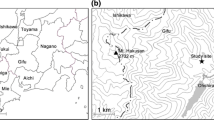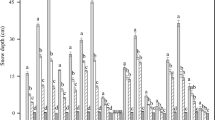Abstract
We examined the effects of treefall gap size and soil properties on microbial biomass dynamics in an undisturbed mature-phase humid subtropical broadleaved forest in north-east India. Canopy gaps had low soil moisture and low microbial biomass suggesting that belowground dynamics accompanied changes in light resources after canopy opening. High rainfall in the region causes excessive erosion/leaching of top soil and eventually soil fertility declines in treefall gaps compared to understorey. Soil microbial population was less during periods when temperature and moisture conditions are low, while it peaked during rainy season when the litter decomposition rate is at its peak on the forest floor. Greater demand for nutrients by plants during rainy season (the peak vegetative growth period) limited the availability of nutrients to soil microbes and, therefore, low microbial C, N and P. Weak correlations were also obtained for the relationships between microbial C, N and P and soil physico–chemical properties. Gap size did influence the microbial nutrients and their contribution to soil organic carbon, total Kjeldhal nitrogen and available-P. Contribution of microbial C to soil organic carbon, microbial N to total nitrogen were similar in both treefall gaps and understorey plots, while the contribution of microbial P to soil available-P was lower in gap compared to the understorey. These results indicate that any fluctuation in microbial biomass related nutrient cycling processes in conjunction with the associated microclimate variation may affect the pattern of regeneration of tree seedlings in the gaps and hence be related with their size.
Similar content being viewed by others
References
Allen S E, Grimshaw H M, Parkinson J A and Quarnby C 1974 Chemical Analysis of Ecological Materials. Blackwell Scientific Publications, Oxford.
Anderson J M and Ingram J S I 1993 Tropical Soil Biology and Fertility-A Handbook of Methods. 2nd edn. CAB International, Wallingford, UK.
Aweto A O 1981 Secondary succession and soil fertility restoration in south-western Nigeria. II. Soil fertility restoration. J. Ecol. 69, 609–614.
Arunachalam A, Boral L and Maithani K 1994 Effects of ground-fire on nutrient contents in soil and litter in a subtropical forest of Meghalaya. J. Hill Res. 7, 13–16.
Arunachalam A, Maithani K, Pandey H N and Tripathi R S 1996 The impact of disturbance on detrital dynamics and soil microbial biomass of a Pinus kesiya forest in north-east India. For. Ecol. Managem. 88, 273–282.
Barik S K, Pandey H N, Tripathi R S and Rao P 1992 Microenvironmental variability and species diversity in a subtropical broadleaved forest. Vegetatio 103, 31–40.
Bremner E and Van Kessel C 1992 Seasonal and microbial biomass dynamics after addition of lentil and wheat residues. Soil Sci. Soc. Am. J. 56, 1141–1146.
Brokaw N V L 1982 The definition of treefall gap and its effect on measures of forest dynamics. Biotropica 11, 158–160.
Brookes P C, Powlson D S and Jenkinson D S 1982 Measurement of microbial biomass phosphorus in soil. Soil Biol. Biochem. 14, 319–329.
Brookes P C, Powlson D S and Jenkinson D S 1984 Phosphorus in the soil microbial biomass. Soil Biol. Biochem. 16, 169–175.
Chandrashekara U M and Ramakrishnan P S 1994 Vegetation and gap dynamics of a tropical wet evergreen forest in the western ghats of Kerala, India. J. Trop. Ecol. 10, 337–354.
Clark D B 1990 The role of disturbance in the regeneration of neotropical moist forest. In Reproductive Ecology of Tropical Forest Plants. Eds. K S Bawa and M Hadeley. pp 291–315. MAB-UNESCO.
Connell J H 1978 Diversity in tropical rain forest and coral reefs. Science, 199, 1302–1310.
Das A K, Boral L, Tripathi R S and Pandey H N 1997 Nitrogen mineralization and microbial biomass-N in soil of a subtropical forest of Meghalaya, India. Soil Biol. Biochem. 29, 1609–1612.
Denslow J S 1987 Tropical rainforest gaps and tree species diversity. Ann. Rev. Ecol. Syst. 18, 431–451.
Diaz-Ravina M, Carballas T and Acea M J 1988 Microbial biomass and its metabolic activity in four acid soils. Soil Biol. Biochem. 20, 817–823.
Hernot J and Robertson G P 1994 Vegetation removal in two soils of the humid subtropics: Effect on microbial biomass. Soil Biol. Biochem. 26, 111–116.
Jenkinson D S and Powlson D S 1976 The effect of biocidal treatments on metabolism in soil - V. A method for measuring soil biomass. Soil Biol. Biochem. 8, 209–213.
Johnson L F and Curl E A 1972 Methods for the Research on Ecology of Soil-Borne Plant Pathogens. Burgess Publishing Co., Minneapolis, Minnesota.
Joergensen R G, Anderson T H and Wolters T 1995 Carbon and nitrogen relationships in the microbial biomass of soils in beech (Fagus sylvatica) forests. Biol. Fert. Soils 19, 141–147.
Luizao R C C, Bonde T A and Rosswall T 1992 Seasonal variation of microbial biomass - the effect of clear felling in a tropical rain forest and establishment of pasture of clearfelling in a tropical rain forest and establishment of pasture in the Central Amazon. Soil Biol. Biochem. 24, 805–813.
Maithani K, Tripathi R S, Arunachalam A and Pandey H N 1996 Seasonal dynamics of microbial C, N and P during regrowth of a disturbed subtropical humid forest in north-east India. Appl. Soil Ecol. 4, 31–37.
Maithani K, Arunachalam A, Tripathi R S and Pandey H N 1998 Influence of leaf litter quality on N mineralization in soils of subtropical humid forest regrowths. Biol. Fert. Soils, 27, 44–50.
Martikainen P J and Palojarvi A 1990 Evaluation of the fumigationextraction method for the determination of microbial C and N in a range of forest soils. Soil Biol. Biochem. 22, 797–802.
Meer Van der P J, Bongers F, Chatrou L and Riera B 1994 Defining canopy gaps in a tropical rain forest: Effects on gap size and turnover time. Acta Oecologica 15, 701–714.
Ostertag R 1998 Belowground effects of canopy gaps in a tropical wet forest. Ecology 79, 1294–1304.
Pascoe E H 1950 A Manual of the Geology of India and Burma, GSI, New Delhi.
Rao P, Barik S K, Pandey H N and Tripathi R S 1990 Community composition and tree population structure in a subtropical broadleaved forest along a disturbance gradient. Vegetatio 88, 151–162.
Rao P, Barik S K, Pandey H N and Tripathi R S 1997 Tree seed germination and seedling establishment in treefall gaps and understorey in a subtropical forest of northeast India. Aust. J. Ecol. 22, 136–145.
Sanford Jr. R 1989 Fine root biomass under a tropical forest light gap opening in Costa Rica. J. Trop. Ecol. 5, 251–256.
Sarathchandra S V, Perrott K W and Upsdell M P 1984 Microbiological and biochemical characteristics of a range of New Zealand soils under established pastures. Soil Biol. Biochem. 16, 177–183.
Srivastava S C and Singh J S 1988 Carbon and phosphorus in the soil biomass of some tropical soils of India. Soil Biol. Biochem. 24, 711–714.
Singh J S, Raghuvanshi A S, Singh R S and Srivastava S C 1989 Microbial biomass acts as a source of plant nutrients in dry tropical forest and savanna. Nature (London) 399, 499–500.
Singh R S, Srivastava S C, Raghuvanshi A S, Singh J S and Singh S P 1991 Microbial C, N and P in dry tropical savanna: Effects of burning and grazing. J. Appl. Ecol. 28: 869–878.
Vance E D, Brookes P C and Jenkinson D S 1987 Microbial biomass measurements in forest soils: The use of the chloroform fumigation incubation method for strongly acid soils. Soil Biol. Biochem. 19, 697–702.
Waksman S A 1952 Soil Microbiology. John Wiley & Sons, New York.
Watt A S 1947 Pattern and process in the plant community. J. Ecol. 35, 1–22.
Williams B L and Sparling G P 1984 Extractable N and P in relation to microbial biomass in UK acid organic soils. Plant Soil 76, 139–148.
Zar J H 1974 Biostatistical Analysis. 2nd edn, Prentice-Hall, Englewood Cliffs, New Jersey.
Rights and permissions
About this article
Cite this article
Arunachalam, A., Arunachalam, K. Influence of gap size and soil properties on microbial biomass in a subtropical humid forest of north-east India. Plant and Soil 223, 187–195 (2000). https://doi.org/10.1023/A:1004828221756
Issue Date:
DOI: https://doi.org/10.1023/A:1004828221756




